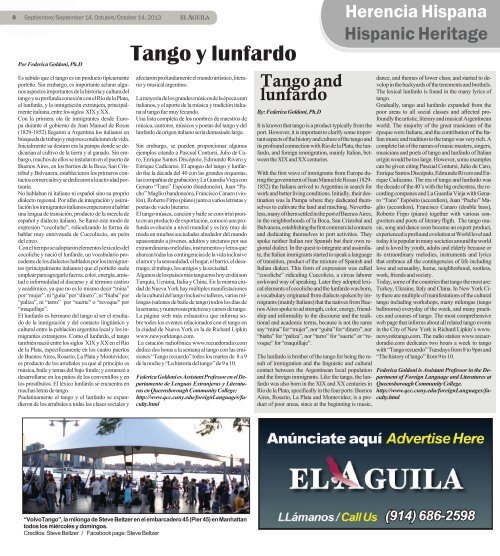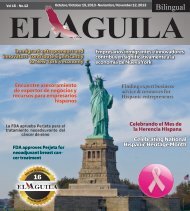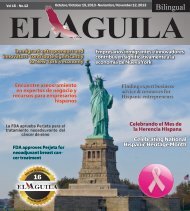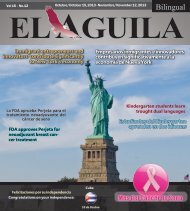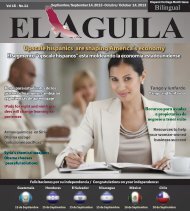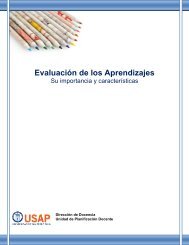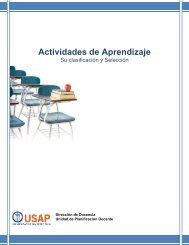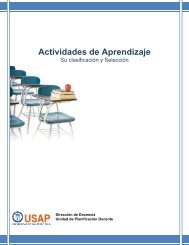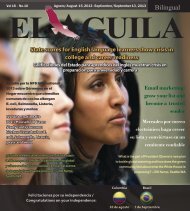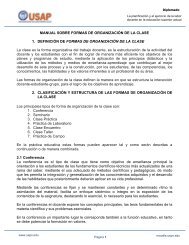You also want an ePaper? Increase the reach of your titles
YUMPU automatically turns print PDFs into web optimized ePapers that Google loves.
8 Septiembre/September 14, Octubre/October 14, 2013<br />
Por Federica Goldoni, Ph.D<br />
Es sabido que el tango es un producto típicamente<br />
porteño. Sin embargo, es importante aclarar algunos<br />
aspectos importantes de la historia y cultura del<br />
tango y su profunda conexión con el Río de la Plata,<br />
el lunfardo, y la inmigración extranjera, principalmente<br />
italiana, entre los siglos XIX y XX.<br />
Con la primera ola de inmigrantes desde Europa<br />
durante el gobierno de Juan Manuel de Rosas<br />
(1829-1852) llegaron a Argentina los italianos en<br />
búsqueda de trabajo y mejores condiciones de vida.<br />
Inicialmente su destino era la pampa donde se dedicarían<br />
al cultivo de la tierra y al ganado. Sin embargo,<br />
muchos de ellos se instalaron en el puerto de<br />
Buenos Aires, en los barrios de la Boca, San Cristóbal<br />
y Balvanera, establecieron los primeros contactos<br />
comerciales y se dedicaron a la actividad portuaria.<br />
No hablaban ni italiano ni español sino su proprio<br />
dialecto regional. Por afán de integración y asimilación<br />
los inmigrantes italianos empezaron a hablar<br />
una lengua de transición, producto de la mezcla de<br />
español y dialecto italiano. Se llamó este modo de<br />
expresión “cocoliche”, ridiculizando la forma de<br />
hablar muy enrevesada de Cuccoliccio, un peón<br />
del circo.<br />
Con el tiempo se adoptaron elementos lexicales del<br />
cocoliche y nació el lunfardo, un vocabulario procedente<br />
de los dialectos hablados por los inmigrantes<br />
(principalmente italianos) que el porteño suele<br />
emplear para agregarle fuerza, color, energía, amistad<br />
e informalidad al discurso y al término castizo<br />
y académico, ya que no es lo mismo decir “mina”<br />
por “mujer”, ni “guita” por “dinero”, ni “biaba” por<br />
“paliza”, ni “tarro” por “suerte” o “revoque” por<br />
“maquillaje”.<br />
El lunfardo es hermano del tango al ser el resultado<br />
de la inmigración y del contacto lingüístico y<br />
cultural entre la población argentina local y los inmigrantes<br />
extranjeros. Como el lunfardo, el tango<br />
también nació entre los siglos XIX y XX en el Rio<br />
de la Plata, específicamente en los cuatro puertos<br />
de Buenos Aires, Rosario, La Plata y Montevideo;<br />
es producto de los arrabales ya que al principio es<br />
música, baile y temas del bajo fondo; y comenzó a<br />
desarrollarse en los patios de los conventillos y en<br />
los prostíbulos. El léxico lunfardo se encuentra en<br />
muchas letras de tango.<br />
Paulatinamente el tango y el lunfardo se expandieron<br />
de los arrabales a todas las clases sociales y<br />
EL <strong>AGUILA</strong><br />
Tango y lunfardo<br />
afectaron profundamente el mundo artístico, literario<br />
y musical argentino.<br />
La mayoría de los grandes músicos de la época eran<br />
italianos, y el aporte de la música y tradición italiana<br />
al tango fue muy fecundo.<br />
Una lista completa de los nombres de maestros de<br />
música, cantores, músicos y poetas del tango y del<br />
lunfardo de origen italiano sería demasiado larga.<br />
Sin embargo, se pueden proporcionar algunos<br />
ejemplos citando a Pascual Contursi, Julio de Caro,<br />
Enrique Santos Discépolo, Edmundo Rivero y<br />
Enrique Cadícamo. El apogeo del tango y lunfardo<br />
fue la década del 40 con las grandes orquestas,<br />
las compañías de grabación y La Guardia Vieja con<br />
Genaro “Tano” Espósito (bandoneón), Juan “Pacho”<br />
Maglio (bandoneón), Francisco Canaro (violón),<br />
Roberto Firpo (piano) junto a varios letristas y<br />
poetas de vuelo literario.<br />
El tango música, canción y baile se convirtió pronto<br />
en un producto de exportación, conoció una profunda<br />
evolución a nivel mundial y es hoy muy de<br />
moda en muchas sociedades alrededor del mundo<br />
apasionando a jóvenes, adultos y ancianos por sus<br />
extraordinarias melodías, instrumentos y letras que<br />
abarcan todas las contingencias de la vida inclusive<br />
el amor y la sensualidad, el hogar, el barrio, el desarraigo,<br />
el trabajo, los amigos y la sociedad.<br />
Algunos de los países más tangueros hoy en día son<br />
Turquía, Ucrania, Italia y China. En la misma ciudad<br />
de Nueva York hay múltiples manifestaciones<br />
de la cultural del tango inclusive talleres, varias milongas<br />
(salones de baile de tango) todos los días de<br />
la semana, y numerosas prácticas y cursos de tango.<br />
La página web más exhaustiva que informa sobre<br />
todos los eventos relacionados con el tango en<br />
la ciudad de Nueva York es la de Richard Lipkin<br />
www.newyorktango.com.<br />
La estación radiofónica www.recuedoradio.com<br />
dedica dos horas a la semana al tango con las emisiones<br />
“Tango recuerdo” todos los martes de 8 a 9<br />
de la noche y “La historia del tango” de 9 a 10.<br />
Federica Goldoni es Assistant Professor en el Departamento<br />
de Lenguas Extranjeras y Literaturas<br />
en Queensborough Community College;<br />
http://www.qcc.cuny.edu/foreignLanguages/faculty.html<br />
“VolvoTango”, la milonga de Steve Beltzer en el embarcadero 45 (Pier 45) en Manhattan<br />
todos los miércoles y domingos.<br />
Creditos: Steve Beltzer / Facebook page: Steve Beltzer<br />
Tango and<br />
lunfardo<br />
By: Federica Goldoni, Ph.D<br />
It is known that tango is a product typically from the<br />
port. However, it is important to clarify some important<br />
aspects of the history and culture of the tango and<br />
its profound connection with Rio de la Plata, the lunfardo,<br />
and foreign immigration, mainly Italian, between<br />
the XIX and XX centuries.<br />
With the first wave of immigrants from Europe during<br />
the government of Juan Manuel de Rosas (1829-<br />
1852) the Italians arrived to Argentina in search for<br />
work and better living conditions. Initially, their destination<br />
was la Pampa where they dedicated themselves<br />
to cultivate the land and ranching. Nevertheless,<br />
many of them settled in the port of Buenos Aires,<br />
in the neighborhoods of la Boca, San Cristobal and<br />
Balvanera, establishing the first commercial contacts<br />
and dedicating themselves to port activities. They<br />
spoke neither Italian nor Spanish but their own regional<br />
dialect. In the quest to integrate and assimilate,<br />
the Italian immigrants started to speak a language<br />
of transition, product of the mixture of Spanish and<br />
Italian dialect. This form of expression was called<br />
“cocoliche” ridiculing Cuccolicio, a circus laborer<br />
awkward way of speaking. Later they adopted lexical<br />
elements of cocoliche and the lunfardo was born,<br />
a vocabulary originated from dialects spoken by immigrants<br />
(mainly Italians) that the natives from Buenos<br />
Aires spoke to ad strength, color, energy, friendship<br />
and informality to the discourse and the traditional<br />
and academic terms, because is not the same<br />
say “mina” for “mujer”, nor “guita” for “dinero”, nor<br />
“biaba” for “paliza”, nor “tarro” for “suerte” or “revoque”<br />
for “maquillaje”.<br />
The lunfardo is brother of the tango for being the result<br />
of immigration and the linguistic and cultural<br />
contact between the Argentinean local population<br />
and the foreign immigrants. Like the tango, the lunfardo<br />
was also born in the XIX and XX centuries in<br />
Rio de la Plata, specifically in the four ports: Buenos<br />
Aires, Rosario, La Plata and Montevideo; is a product<br />
of poor areas, since at the beginning is music,<br />
Herencia Hispana<br />
Hispanic Heritage<br />
dance, and themes of lower class; and started to develop<br />
in the backyards of the tenements and brothels.<br />
The lexical lunfardo is found in the many lyrics of<br />
tango.<br />
Gradually, tango and lunfardo expanded from the<br />
poor areas to all social classes and affected profoundly<br />
the artistic, literary and musical Argentinean<br />
world. The majority of the great musicians of the<br />
époque were Italians, and the contribution of the Italian<br />
music and tradition to the tango was very rich. A<br />
complete list of the names of music masters, singers,<br />
musicians and poets of tango and lunfardo of Italian<br />
origin would be too large. However, some examples<br />
can be given citing Pascual Contursi, Julio de Caro,<br />
Enrique Santos Discépalo, Edmundo Rivero and Enrique<br />
Cadicamo. The era of tango and lunfardo was<br />
the decade of the 40’s with the big orchestras, the recording<br />
companes and La Guardia Vieja with Genaro<br />
“Tano” Espósito (accordion), Juan “Pacho” Maglio<br />
(accordion), Francisco Canaro (double bass),<br />
Roberto Firpo (piano) together with various songwriters<br />
and poets of literary fligth. The tango music,<br />
song and dance soon became an export product,<br />
experienced a profound evolution at World level and<br />
today it is popular in many societies around the world<br />
and is loved by youth, adults and elderly because or<br />
its extraordinary melodies, instruments and lyrics<br />
that embrace all the contingencies of life including<br />
love and sensuality, home, neighborhood, rootless,<br />
work, friends and society.<br />
Today, some of the countries that tango the most are:<br />
Turkey, Ukraine, Italy and China. In New York City<br />
there are multiple of manifestations of the cultural<br />
tango including workshops, many milongas (tango<br />
ballrooms) everyday of the week, and many practices<br />
and courses of tango. The most comprehensive<br />
web page that informs about all related tango events<br />
in the City of New York is Richard Lipkin’s www.<br />
newyorktango,com. The radio station www.recuerdoradio.com<br />
dedicates two hours a week to tango<br />
with “Tango recuerdo” Tuesdays from 8 to 9pm and<br />
“The history of tango” from 9 to 10.<br />
Federica Goldoni is Assistant Professor in the Department<br />
of Foreign Language and Literatures at<br />
Queensborough Community College.<br />
http://www.qcc.cuny.edu/foreignLanguages/faculty.html


